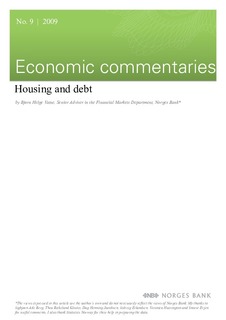| dc.contributor.author | Vatne, Bjørn Helge | |
| dc.date.accessioned | 2018-08-23T07:43:15Z | |
| dc.date.available | 2018-08-23T07:43:15Z | |
| dc.date.issued | 2009 | |
| dc.identifier.uri | http://hdl.handle.net/11250/2558967 | |
| dc.description.abstract | Residential mortgage loans account for more than half of banks’ total lending. It is therefore important to understand the risk factors related to housing debt when analysing financial stability. Two factors are of particular interest: household debt-servicing capacity and the ratio of mortgage debt to the value of the dwelling. According to income tax self-assessment forms, 80 per cent of total household debt was held by homeowners in 2007. One third of household debt growth was related to home purchases. In one in nineteen households, debt was higher than the value of the dwelling while more than 20 per cent of household income was spent on interest payments. These households accounted for close to one fifth of household debt. Stress tests show that households with large mortgages are vulnerable to higher interest rates and a fall in house prices. | nb_NO |
| dc.language.iso | eng | nb_NO |
| dc.publisher | Norges Bank | nb_NO |
| dc.relation.ispartofseries | Economic Commentaries;9/2009 | |
| dc.rights | Attribution-NonCommercial-NoDerivatives 4.0 Internasjonal | * |
| dc.rights.uri | http://creativecommons.org/licenses/by-nc-nd/4.0/deed.no | * |
| dc.title | Housing and Debt | nb_NO |
| dc.type | Others | nb_NO |
| dc.description.version | publishedVersion | nb_NO |
| dc.subject.nsi | VDP::Samfunnsvitenskap: 200::Økonomi: 210::Samfunnsøkonomi: 212 | nb_NO |
| dc.source.pagenumber | 4 | nb_NO |

